Compassionate care for lasting smiles

The General Dentistry department at The Dental Boutique, JLT, Dubai is dedicated to providing the highest quality of dental care to our patients. We offer a complete range of general dentistry services to meet the diverse needs of our patients.
- Teeth cleaning, scaling, and polishing services to remove plaque and tartar buildup
- Composite fillings for cavities and minor repairs
- Root canal treatment to save infected teeth
- Dental crowns to protect and strengthen damaged teeth
- Dental bridges to replace missing teeth
- Tooth extraction when necessary
- Dentures to replace multiple missing teeth
- Periodontal treatments to prevent and treat gum disease

Teeth cleaning, scaling & polishing

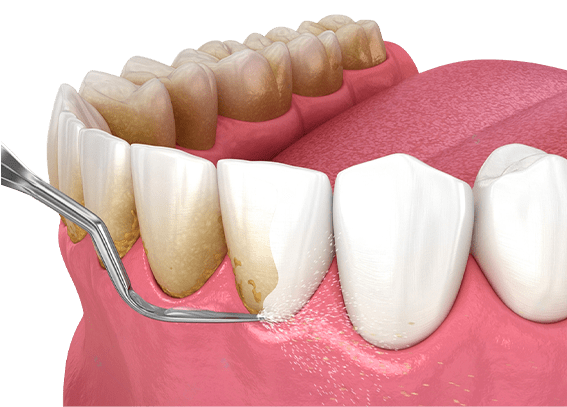
Are you cleaning your teeth right?
Improve your personal oral hygiene with teeth cleaning, often called “Teeth Scaling and Polishing”
Even with brushing and flossing, there’s still some corners that are not fully reached.
With our teeth cleaning services, you can definitely say that your smile is sparkling clean and healthy all throughout!
It is recommended to go for your dental cleaning every six months, to keep your gums free from disease. This also ensures that your pearly whites are free from any plaque, calculus and surface stains.
For patients wearing braces, we advise them to schedule their hygiene appointments more frequently to keep their teeth in great health during their treatment. Our professional dentists only use modern instruments and the latest technology for teeth cleaning in Dubai.
At The Dental Boutique, your overall oral health is our top priority, and this begins by helping you maintain clean teeth and gums.
Composite fillings
One of the most common problems that people face are dental cavities/caries. The best treatment for cavities is dental/tooth fillings. Tooth fillings are restorations done directly into the cavity after cleaning the part infected by bacteria. The dental fillings are usually white or silver. At The Dental Boutique, we offer tooth-colored composite white fillings for a fresh feeling and better aesthetics. Composite fillings are also used to repair cracked or broken teeth and teeth that have been worn down from misuse (such as from nail-biting or tooth grinding).
Root canal treatment
We understand that people fear root canals and tend to avoid undergoing the treatment. However, here, at The Dental Boutique, we carefully craft the entire process to eliminate any fear attached to this procedure. In fact, we turn it into a very positive experience. We have expert and skilled dentists to ensure that every root canal procedure is precise, seamless, and pain-free.
Why do you need a Root Canal?
Decaying teeth or cavities, if left untreated, develop further and gradually destroy a significant portion of the tooth before reaching the ‘pulp’ of the tooth. This pulp is a thin and soft tissue present in the tooth canals, predominantly consisting of nerves and blood vessels. If the infection reaches the pulp, you experience ‘toothache’. At this stage, the tooth can only be saved by performing a root canal treatment. Root canal treatment is essential to prevent the infection from spreading, thereby eliminating the need for tooth extraction.
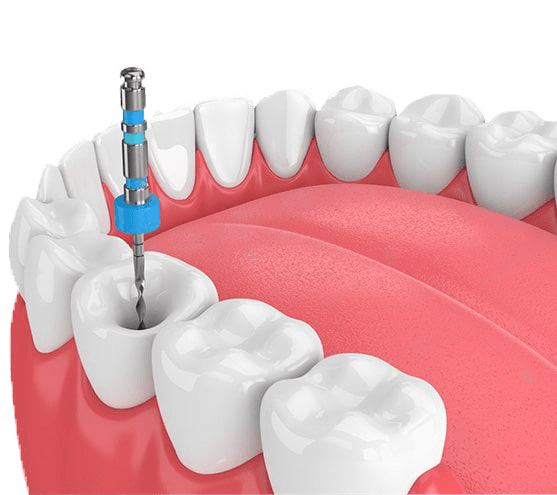
Root canal treatment procedure
Administration of anesthetic
Firstly, an anesthetic is administered if needed to the patient to ease any anxiety and make the treatment pain-free and comfortable.
Access hole
A small opening is made in the crown of the tooth to access the pulp.
Filling the canals
The empty canals are then filled with a flexible, rubbery dental material called gutta-percha.
Temporary filling placement
A temporary dental fillings placed to seal the tooth and prevent bacteria from re-entering.
Pulp removal
Tiny dental instruments are used to remove the nerves, blood vessels and tissues inside the tooth. Once the pulp is removed, the pulp chamber and root canals are cleaned, disinfected and shaped.
Placing the final restoration
In most cases, you’ll need a dental crownto protect the treated tooth and restore your bite.
Crowns are custom-made, and fabrication usually takes two to three weeks.
When your crown is ready, the temporary filling is removed and the permanent crown is placed. In some instances, you may be able to receive a crown during the same appointment.

Re-contouring of the gums
Sometimes, the natural contours of the gums are uneven and asymmetrical resulting in an unaesthetic smile. Such gum lines are re-contoured to make them look more pleasing.
Dental crowns
A dental crown is a tooth-shaped “cap” that is placed over a tooth — to cover the tooth to restore its shape and size, strength, and improve its appearance. The crowns, when cemented into place, fully encase the entire visible portion of a tooth that lies at and above the gum line.
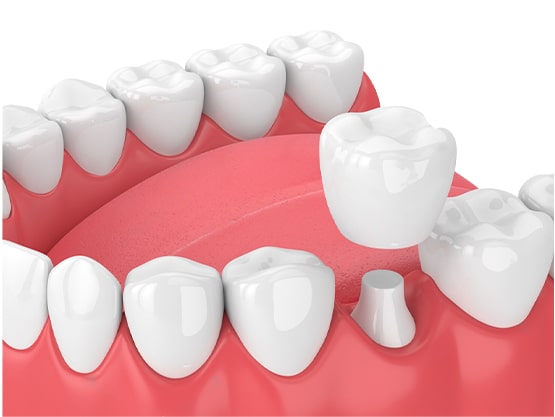
Why is a dental crown needed?
Dental bridges
A dental bridge may be recommended if you’re missing one or more teeth. Gaps left by missing teeth eventually cause the remaining teeth to rotate or shift into the empty spaces, resulting in a bad bite. The imbalance caused by missing teeth can also lead to gum disease and temporomandibular joint (TMJ) disorders.
Dental Bridges are commonly used to replace one or more missing teeth. They span the space where the teeth are missing. Bridges are cemented to the natural teeth or implants surrounding the empty space. As with crowns, you have a choice of materials for bridges.
Your dentist can help you decide which to use, based on the location of the missing tooth (or teeth), its function, aesthetic considerations, and cost. Porcelain or ceramic bridges can be matched to the color of your natural teeth.
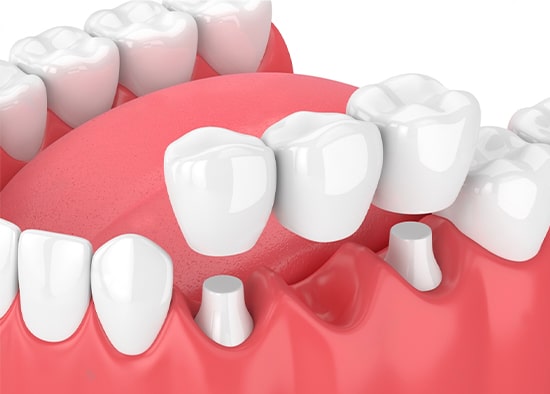
Dentures
A denture is a removable replacement for missing teeth and surrounding tissues. Two types of dentures are available — complete and partial dentures.
Complete Dentures are used when all the teeth are missing.
Partial Dentures are used when some natural teeth remain.
Tooth extraction
Although permanent teeth are meant to last a lifetime, there are several reasons why tooth extraction may be needed. A very common reason involves a tooth that is too badly damaged, from trauma or decay, to be repaired. Other reasons include:
A crowded mouth – Sometimes dentists pull teeth to prepare the mouth for orthodontia. The goal of orthodontia is to properly align the teeth, which may not be possible if your teeth are too big for your mouth. Likewise, if a tooth cannot break through the gum (erupt) because there is not room in the mouth for it, your dentist may recommend pulling it.


Infection – If tooth decay or damage extends to the pulp — the center of the tooth containing nerves and blood vessels — bacteria in the mouth can enter the pulp, leading to infection. Often this can be corrected with root canal therapy (RCT), but if the infection is so severe that antibiotics or RCT do not cure it, extraction may be needed to prevent the spread of infection.
Risk of infection – If your immune system is compromised (for example, if you are receiving chemotherapy or are having an organ transplant), even the risk of infection in a particular tooth may be reason enough to pull the tooth.
Periodontal (Gum) Disease – If periodontal disease — an infection of the tissues and bones that surround and support the teeth have caused loosening of the teeth, it may be necessary to the pull the tooth/ teeth.
Periodental treatments
There are a variety of treatments for gum disease depending on the stage of the disease, how you may have responded to earlier treatments, and your overall health. Treatments range from nonsurgical therapies that control bacterial growth to surgery to restore supportive tissues.

Professional dental cleaning
During a typical checkup, your dentist or dental hygienist will remove the plaque and tartar (plaque that builds up and hardens on the tooth surface and can only be removed with professional cleaning) from above and below the gum line of all teeth. If you have some signs of gum disease, your dentist may recommend professional dental cleaning more than twice a year.
Scaling and root planning
This is a deep cleaning whereby plaque and tartar from above and below the gum line are scraped away (scaling), and rough spots on the tooth root are made smooth (planning). Smoothing the rough spots removes bacteria and provides a clean surface for the gums to reattach to the teeth. Scaling and root planning are done if your dentist determines that you have plaque and calculus (hardened plaque, also called tartar) under the gums that need to be removed.
Surgical treatments for gum disease
In some patients, the nonsurgical procedure of scaling and root planning is all that is needed to treat gum diseases. Surgery is needed when the tissue around the teeth is unhealthy and cannot be repaired with nonsurgical options.
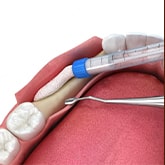
Flap surgery/pocket reduction surgery
During this procedure, the gums are lifted back, and the tarter is removed. In some cases, irregular surfaces of the damaged bone are smoothed to limit areas where disease-causing bacteria can hide. The gums are then placed so that the tissue fits snugly around the tooth. This method reduces the size of the space between the gum and tooth, thereby decreasing the areas where harmful bacteria can grow and decreasing the chance of serious health problems associated with periodontal disease.
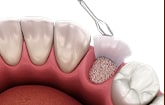
Bone grafts
This procedure involves using fragments of your own bone, synthetic bone, or donated bone to replace bone destroyed by gum disease. The grafts serve as a platform for the regrowth of bone, which restores stability to teeth. New technology, called tissue engineering, encourages your own body to regenerate bone and tissue at an accelerated rate.

Soft tissue grafts
This procedure reinforces thin gums or fills in places where gums have receded. Grafted tissue, most often taken from the roof of the mouth, is stitched in place, adding tissue to the affected area.
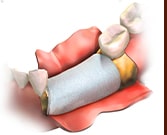
Guided tissue regeneration
Performed when the bone supporting your teeth has been destroyed, this procedure stimulates bone and gum tissue growth. Done in combination with flap surgery, a small piece of mesh-like fabric is inserted between the bone and gum tissue. This keeps the gum tissue from growing into the area where the bone should be, allowing the bone and connective tissue to regrow to better support the teeth.

Bone surgery
Smooths shallow craters in the bone due to moderate and advanced bone loss. Following flap surgery, the bone around the tooth is reshaped to decrease the craters. This makes it harder for bacteria to collect and grow.

Meet our team
Know your general dentists
See what makes our clients smile

FAQs









